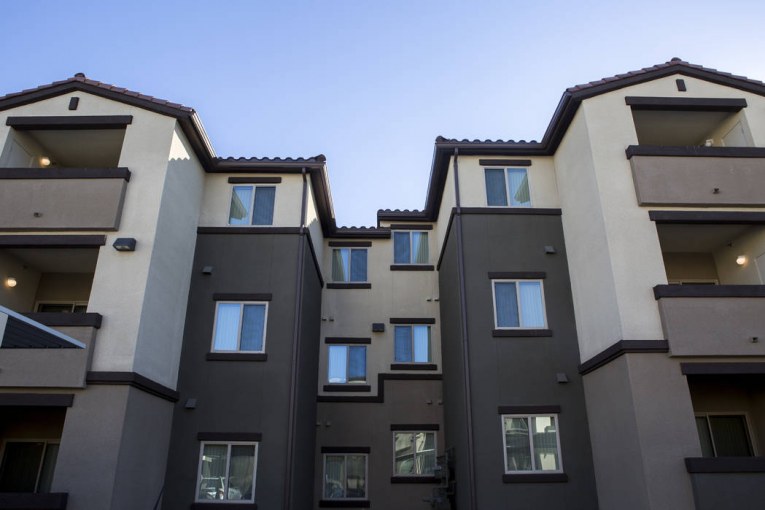

At last week’s Planning Commission meeting, the Planning Commission recommended forwarding a project to the city council with a caveat on the affordable housing proposal – “subject to the concurrence of the Social Services Commission.” On Monday, the Social Services Commission will consider an amendment to the Affordable Rental Housing Requirements.
The proposed amendment is separate from the comprehensive update currently underway.
Back in November, when the Social Services Commission reviewed the proposed 3820 Chiles Road Affordable Housing Plan, the applicant presented two possibilities – 34 on-site units consisting of 5% median income units (11 units) and 10% for moderate income units, or an alternative plan that grants an annual contribution to the city’s Housing Trust Fund in perpetuity for at least $100,000 a year.
Staff notes that while the commission did not take formal action on the proposal, many members “applauded the applicant’s creativity and liked that the project is workforce oriented.”
At last week’s meeting of the Planning Commission, the applicant noted that it is no longer proposing on-site affordable units. Instead, they have decided to propose devoting 1.65 of its rental income to the city’s Housing Trust Fund in perpetuity.
The estimate is that the first year it could contribute around $125,000 and go upwards of $300,000 as rents increase over time.
In order for this arrangement to take place, an amendment to the city Affordable Housing Ordinance is required.
In the staff report, staff notes they are open “to ideas on how to define what constitutes an appropriate annual contribution.”
Staff notes, “As proposed by the 3820 Chiles Road applicant, contributing 1.65 percent of its rental income is economically feasible for their project pro forma, but this may or may not be the case for  others.”
others.”
The Housing Trust Fund is included in the City’s overall budget, the staff report notes, “but is a separate fund from general city dollars (General Fund). Monies in the Housing Trust Fund can only be used on efforts to support affordable housing.”
Included in the type of expenditures eligible for this fund:
Gap funding for a new affordable housing project.
- Funding for rehabilitation/renovation work on an existing affordable housing site.
- Costs for staff time to administer/manage the city’s affordable housing program(s), including costs for consultants or contractors related to affordable housing issues.
- Monitoring of affordable housing sites/units for income qualifications, other obligations, etc.
- Costs related to homelessness (specifically, housing-related costs).
- Outreach and provision of information to community.
Staff is looking for feedback from the commission on several questions: How should the City define what constitutes an appropriate annual contribution to the Housing Trust Fund? How should the City manage and allocate the funding received? How should the proposed amendment work with the comprehensive update already underway?
The need for such an approach has to do with the costs of the project.
The project’s developer Chuck Cunningham explained to the Planning Commission: “We knew a long time ago based on our pro formas that we couldn’t meet… the 35 percent (affordable housing requirement) was totally beyond reach. Even the 5-5-5 for our product type is impossible.”
That was later confirmed by the Plescia study.
Mr. Cunningham said, “We had to do something. We began looking at alternatives.”
He said, “It turns out we could do 3.5% total without even extremely low units.”
Why are some of the projects able to get to 15%? He showed a chart that illustrated the vast difference in revenue generated in rental units that rent by the unit versus the bed.
“The income economics are substantially different,” he explained. “That’s a big deal.”
There are other factors on the cost size. For instance, the amount of square footage per bed is substantially higher for their project than for student housing. Beds per unit are under two for their project versus over six for student projects.
Parking is a factor – students do not have to have as much parking next to campus, while they have the expectation of having a place to park their car. Connection fees and impact fees also work against them since they don’t distinguish between number of rooms.
The idea of the revenue stream was a way to replace funding from redevelopment agencies. “How did we get to 1.65 percent?” he asked. “We basically looked at the internal subsidy that was involved with the median and moderate income units… and that then translated to 1.65 percent of gross rent. The fundamental reason is that it’s what the project can afford.”
At the Planning Commission, the issue was raised about the overall viability of such projects – which was also discussed in November at the Social Services Commission as well as the fact that student housing with the by-the-bed rentals allowed for a more flexible and expansive affordable housing plan.
Staff is expecting to return in the spring with the update of the overall affordable housing plan prior to its expiration on June 30.
—David M. Greenwald reporting

